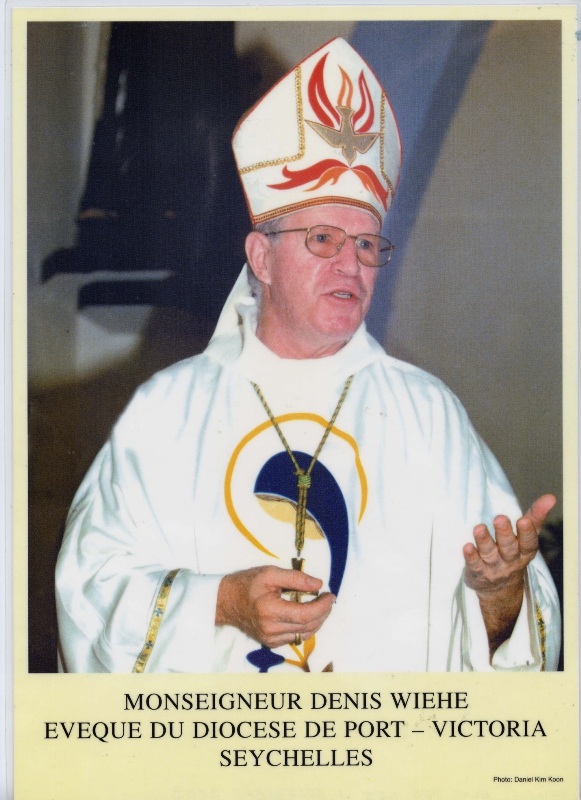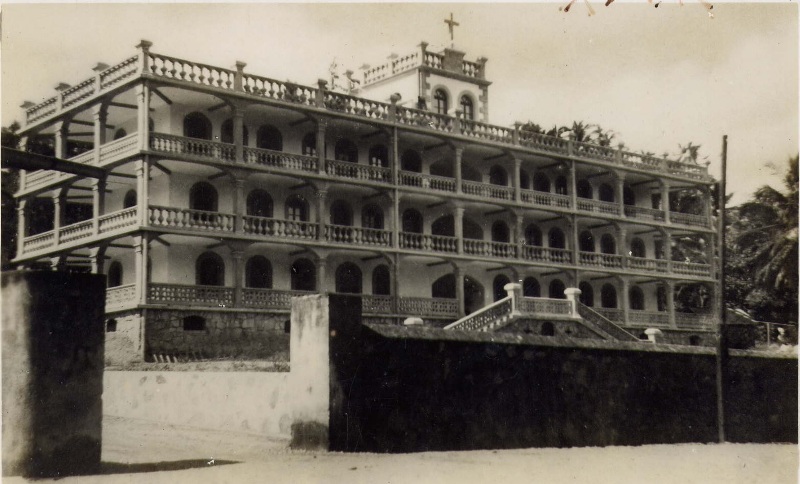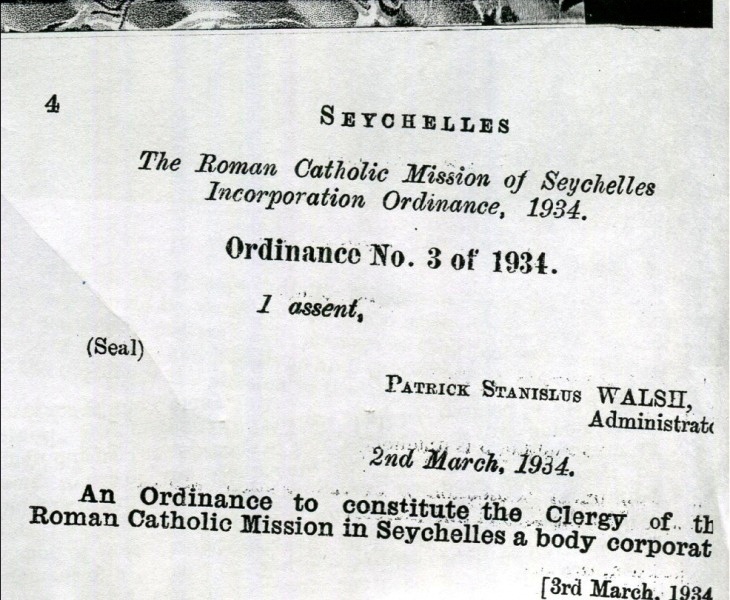The Catholic Diocese of Victoria is 125 years old |21 July 2017

July 21, 2017 marked a milestone in the history of the Roman Catholic Church in Seychelles. TONY MATHIOT takes a retrospective look at those hallowed years.
Seychelles became a diocese on July 21, 1892, twelve years after it had been erected as an Apostolic Vicariat on April 5, 1880, and forty years after Pope Pius IX (1792-1878) had established the Catholic Church as an Apostolic Prefecture on November 26, 1852.
Mgr. Marc Hudrisier (1848-1910) who had been appointed Prefect Apostolic in 1890, automatically became the first Bishop of Port Victoria. He had 11 parishes to nurture: Anse aux Pins (1853), La Digue (1853), Baie Ste Anne Praslin (1853), Anse Royale (1866), Anse Boileau (1868), Grand Anse Praslin (1878), Glacis (1882), Port Glaud (1882), Cascade (1884), Baie Lazare (1884) and Takamaka (1888).
The population of Seychelles was about 16,000. There were 23 Roman Catholic Schools that accommodated some 2,129 pupils - including St Louis College established since 1867 by Father Ignace Galfione (1815-1881) and which was under the management of the Mariste Brothers since 1881.
The Evangelisation crusade of the Roman Catholic Mission was under the responsibility of the capuchin priest from Savoie since 1863. And Mgr Hudrisier’s initial concern was to recruit more priests to assist him. Among the inhabitants, many had been baptised by Father Leon des Avanchers (1825-1879) during his first visit in 1851.
The First Sacerdotal ordination in Seychelles took place on September 19, 1895 when Mgr Hudrisier ordained Father Jerome Pattoret (1872-1952). On November 30, 1897, he blessed the church of our Lady of Assumption on La Digue.
In 1910, an English Bishop, Mgr Bernadin Clark (1856-1915) who had converted to Catholicism in 1870, took up the crosier of the Catholic Church in Seychelles. He had been to Seychelles in 1883 and spent 19 years as a residential priest of Cascade where he initiated the construction of St Andrew’s Church - but before he could fulfill his goal, he had to leave Seychelles in 1902, having been appointed Vicar Apostolic of Aden. As bishop of Port Victoria, eight years later, he was not disconcerted with the situation of rivalry between the Catholic Church and the Anglican Church that confronted him. Way back in the 1880s there was smouldering hostilities between the two churches, particularly with regard educational grants. The Catholic Mission was constantly protesting against the fact that the colonial administration accorded the Anglican Church incommensurately more allowances for the running of its school even if the Catholic Church had more educational institutions which required more expenditure. During Mgr. Bernadin Clark’s episcopacy, which ended in 1915, the antagonism between the two churches aggravated when on January 23, 1911 the government opened King’s College as the only secondary undenominational school in the colony. Mgr Clark accused Governor Walter Edward Davidson (1859-1923) of the opening of an Anglican Institution in the guise of introducing the secularisation of education in Seychelles. He got 2,659 inhabitants to sign a petition. King’s College closed down in 1919.
In 1922, the first group of Swiss capuchin priests arrived to replace the Savoyard capuchin priests whose number during a period of 60 years amounted to 55 humble and devoted missionaries. Among them, a few died in Seychelles and were buried in their Parish cemetery or in the Beauvoir cemetery at La Misère. The First Swiss Bishop was Mgr Justin Gumy (1869-1941) who was ordained on September 18, 1921 in Switzerland. His 12-year episcopacy was marked by tragedy, a motivating propensity and sadly, discontentment. In 1925, when a priest, Father Theophile Dumas (1896-1925) 29 years, was found dead in a precipice in the uplands of Cascade, he was tormentingly convinced that the priest had been murdered by some local witch. That same year, he erected the crucifix in Victoria, and carried out extensive renovations on the Cathedral of the Immaculate Conception. He built the Church of St Michael of Archangel at Anse aux Pins which he blessed on January 17, 1929, and the church of St Joseph at Anse Royale which he blessed on January 4, 1931. In 1930, when the old timber presbytery that was adjacent to the Cathedral had become utterly dilapidated, Mgr Gumy approved the construction of the Domus, the wafer-white edifice which served as the priest residence. A disagreement between him and Father Aloys Crausaz (1897-1922) instigated a discord among the missionaries. Consequently, with sentiments of resentment and grievance Mgr Gumy resigned on January 8, 1934. He was succeeded by Mgr Ernest Joye (1880-1962).
Up till then, the Roman Catholic mission with the tacit understanding of the colonial Government had been able to exercise its work through sustained generous donations from various devout Catholics in the colony. On March 3, 1934, an ordinance to constitute the clergy of the Roman Catholic Mission in Seychelles a body corporate, came into force. Thus, ordinance No.3 of 1934 was a milestone that gave impetus to the Roman Catholic Mission’s various undertakings. From then on, it was entitled “to hold and possess moveable and immoveable properties for worship, schools, buildings, tenements and estates for the residence of the clergy….for charitable and educational purposes, to acquire property by purchase donation intervivos by legacy or otherwise”.
It was in 1879 that the Roman Catholic Mission of Seychelles acquired its first property. This was at Rivière Sèche, La Misère, part of which the Beauvoir cemetery is located. It opened in 1873 for the burial of Sister Francois – Xavier Gavin (1836-1873). On September 1, 1935, the organ of the Roman Catholic Mission was launched by Father Maurice Roh (1896-1963). It was called L’Action Catholique. In 1957 it was renamed L’Echo des Iles.
In 1938, the newly ordained bishop, Mgr Olivier Maradan (1899-1975) gave the Colonial Government a portion of the Roman Catholic Mission property at Baie Ste Anne Praslin to build the new cottage hospital. The Roman Catholic Mission had acquired the property in 1925.
In 1940, Father Roh established a hospice and an orphanage in Victoria. In 1942, he founded the Congregation of Ste Elizabeth expressly to manage these two institutions.
First Seychellois Priest
During their evangelisation work, the missionaries were confronted with many instances of abject poverty throughout the colony. Charity and education were primordial adjuncts on their religious calendar. History gives us ample testimony…Like in 1943, while the storm of the Second World War was raging across the globe, the colony was experiencing the scourge of poverty. The Roman Catholic Mission was allowed, by the enactment of an ordinance, to establish a charitable society called ‘L’oeuvre de St. Antoine’ – to provide by means of donations and subscriptions, food and shelter to poor boys of the colony.
On January 1, 1950, almost a century after the arrival of the First Missionary to Seychelles, the Colony got its First Seychellois priest, Father James Chang-Tave (1918-1981). In 1951, the Salle d’Oeuvres (now Deepam Cinema) opened. For the next twenty-five years, it was the most popular social venue in Victoria among the local population: drama and poetry recitals by Alliance Française and the mission schools, cultural shows, public lectures….
On October 28, 1952, a large congregation attended the ceremony of the blessing of the Cathedral of the Immaculate Conception to mark the centennial anniversary of the establishment of the Roman Catholic (1852-1952).
The 1960s was a period of momentous growth and development. New parishes were created -- The Parish of St Antoine de Padoue, Anse Etoile 1962, The Parish of Good Sheperd, Mont Fleuri 1964. The Roman Catholic Mission was blessed with the expectation of fulfillment and renewed vigour when six Seychellois opted to take the vows of obedience, chastity and poverty. They were – Father Felix Paul (1960), Father Gustave Lafortune (1963), Father Edwin Mathiot (1966), Father Jeremie Bonnelame (1964), Father Gabriel Hoareau (1964), Father Marcel Coopoosamy (1968). For the duration of their priesthood, the local priests would perform their sarcedotal ministry in various parishes with the same unswerving fidelity and an apostolic zeal as their Swiss Capucin colleagues.
In 1961, Dr Maxime Ferrari in collaboration with Father Angelin Zuffery (1909-1999) formed the L’Union Chrétienne Seychelloise, to promote social, moral, cultural and Christian values. The Society created ‘La Societé du Logement’ which built low-cost housing for workers. From 1965 to 1989 L’Union Chrétienne Seychelloise operated as a local branch of Catholic relief Services (established in USA since 1917) during which time it distributed rice, powdered milk, cooking oil and bulgar wheat to school children of Seychelles.
First Seychellois Bishop
On July 25, 1975, as Seychelles reached the threshold of its Independence, the country rejoiced at the Episcopal Ordination of its first Seychellois Bishop, Mgr Felix Paul (1935-2001) who replaced the Apostolic Administrator, Mgr Antoine Aeby (1924-1989).
In 1982, (from April 16-25) the Inter-island Episcopal meeting was held in Seychelles for the first time. This annual gathering of Catholic Bishops from the countries of the Indian Ocean provides opportunity for close examination of Diocesian issues and church subjects with interchange of opinions. The forum was renamed CEDOI (Conférence Episcopal de L’Océan Indien) in 1985. In 1982, when the bishops gathered in Seychelles, Father Xavier Barronet (1927-2012), who in 1995 would become the 8th Bishop of Port Victoria, was the secretary general of Zone Pastoral Inter-île, the organisation responsible for the inter-island meeting.
In 1983, the first three sisters of the Missionaries of Charity arrived in Seychelles and settled at Anse Etoile. The following year, on July 12, 1984, Mother Theresa arrived on Air India to visit her ‘Sisters’. She left on July 20, divinely happy that her congregation had integrated supremely well into their community at the Foyer de Nazareth. That same year on December 29, Mgr Felix Paul blessed their convent.
From the time the Catholic cross was erected on Seychelles soil, nuns have played a pivotal role in the social development of Seychelles, particularly in education. In 2011, the congregation of the St Joseph de Cluny celebrated its 150 years of presence in Seychelles (1861-2011). A total number of 241 sisters had served in the Order, including 56 Seychelloise.
On December 1, 1986, Pope John Paul II (1920-2005) arrived with a 29-strong delegation. It was a Monday of unrestrained rejoicing and vociferous acclamation – and prayer.
From July 23 to July 28, 1990, Mgr Felix Paul was among the 487 bishops who converged at Lome, Togo for the 9th General Assembly for a Symposium des Conferences Episcopal. He was representing CEDOI. From 1989 to the mid 1990s, there was the ordination of a new generation of Seychellois priests. Six in all, plus the ordination of a Deacon, Louis Agathine on February 25, 1996.
The early 1990s were turbulent times for the Seychelles. In 1991, Seychelles changed from a single party popular democracy to a multi-party democratic structure. In 1993, as the people of Seychelles braced themselves to accept a new constitution, unbeknownst to them, another drama was about to unfold in the Diocese of Port Victoria which had just celebrated its centenary in 1992. In fact, the Catholic community was looking forward to the new Cathedral of the Immaculate Conception. The beginning of the year of the New Constitution, 1993 had more or less augured well for the Catholic Church. On January 31, 1993, Mgr Felix Paul had inaugurated the new church of St Peter and Paul at the Parish of Port Glaud. Could it have been an Omen? Peter, being the first Bishop of Rome. And Paul, being …
On Tuesday May 31, 1994, during the morning mass that was held in a makeshift chapel in the compound of Ste Claire’s School, Mgr Felix Paul announced the news of his resignation from the pulpit. Obviously, the congregation was filled with tormented consternation. A few weeks later, Mgr Felix Paul left the Seychelles. Mgr Gilbert Aubry, the bishop of St Denis, La Reunion was appointed Apostolic Administrator of the Diocese of Seychelles. A man of perspective and sound judgement, he was admired and well respected by the Seychellois population.
On June 25, 1995 Mgr Xavier Baronnet (1927-2012) was ordained at Stad Popiler. During his episcopacy, spiritain priests arrived from Madagascar and Africa. On June 12, 2000, by an Act of Legislation, the Roman Catholic Mission became the Roman Catholic Church. Certainly, after 158 years that it arrived in Seychelles, the Catholic Church had accomplished its mission.
The 9th and the actual Bishop of Seychelles, Mgr Denis Wiehe was ordained on August 15, 2001. Befittingly, the new millennium was a new era for the Roman Catholic Church in Seychelles. There were new demands to cope with. Sometimes, seemingly insuperable problematic issues and challenges that required new avenues of consideration on the part of the ecclesiastic institutions. But the militant zeal and ardent involvement of various lay movements like Coeur Vaillant, Jeunes Ouvriers Chrétien, Groupe Rosaire, Kids for Christ or Mouvement Eucharistic des Jeunes helped to intensify the pulse of Catholic fervor across the nation.
Mgr Denis Wiehe’s episcopacy has certainly been a period of progress and accomplishment. The Catholic Church has gained new Parishes: Parish of Holy Spirit at Perseverance (2012), and the Parish of Sacred Heart of Jesus (2014).
In 2008, a Cistercien monastery opened the Harmony, La Misère. This has introduced a new spiritual dimension to the country which had never known the presence of a monastic Order. In 2015, a monumental task was finally accomplished when the Bible was published in Seychellois Creole.
During the last 125 years, nine bishops have headed the Diocese of Victoria and Seychelles have seen 19 of its sons join the priesthood. The first one took his vows in 1950 and the last one Father Collin Underwood was ordained on August 23, 2009.
Presently, the Diocese of Victoria is still under the guidance of the bishop emeritus, Mgr Denis Wiehe. Shortly, he will pass the crosier over to another bishop who will continue the work that Mgr Hudrisier started 125 years ago, with the same religious ardour and the same enduring stoutness of mind. AMEN!








